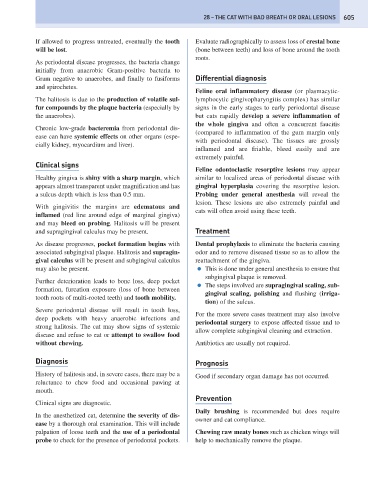Page 613 - Problem-Based Feline Medicine
P. 613
28 – THE CAT WITH BAD BREATH OR ORAL LESIONS 605
If allowed to progress untreated, eventually the tooth Evaluate radiographically to assess loss of crestal bone
will be lost. (bone between teeth) and loss of bone around the tooth
roots.
As periodontal disease progresses, the bacteria change
initially from anaerobic Gram-positive bacteria to
Gram negative to anaerobes, and finally to fusiforms Differential diagnosis
and spirochetes.
Feline oral inflammatory disease (or plasmacytic-
The halitosis is due to the production of volatile sul- lymphocytic gingivopharyngitis complex) has similar
fur compounds by the plaque bacteria (especially by signs in the early stages to early periodontal disease
the anaerobes). but cats rapidly develop a severe inflammation of
the whole gingiva and often a concurrent faucitis
Chronic low-grade bacteremia from periodontal dis-
(compared to inflammation of the gum margin only
ease can have systemic effects on other organs (espe-
with periodontal disease). The tissues are grossly
cially kidney, myocardium and liver).
inflamed and are friable, bleed easily and are
extremely painful.
Clinical signs
Feline odontoclastic resorptive lesions may appear
Healthy gingiva is shiny with a sharp margin, which similar to localized areas of periodontal disease with
appears almost transparent under magnification and has gingival hyperplasia covering the resorptive lesion.
a sulcus depth which is less than 0.5 mm. Probing under general anesthesia will reveal the
lesion. These lesions are also extremely painful and
With gingivitis the margins are edematous and
cats will often avoid using these teeth.
inflamed (red line around edge of marginal gingiva)
and may bleed on probing. Halitosis will be present
and supragingival calculus may be present. Treatment
As disease progresses, pocket formation begins with Dental prophylaxis to eliminate the bacteria causing
associated subgingival plaque. Halitosis and supragin- odor and to remove diseased tissue so as to allow the
gival calculus will be present and subgingival calculus reattachment of the gingiva.
may also be present. ● This is done under general anesthesia to ensure that
subgingival plaque is removed.
Further deterioration leads to bone loss, deep pocket
● The steps involved are supragingival scaling, sub-
formation, furcation exposure (loss of bone between
gingival scaling, polishing and flushing (irriga-
tooth roots of multi-rooted teeth) and tooth mobility.
tion) of the sulcus.
Severe periodontal disease will result in tooth loss,
For the more severe cases treatment may also involve
deep pockets with heavy anaerobic infections and
periodontal surgery to expose affected tissue and to
strong halitosis. The cat may show signs of systemic
allow complete subgingival cleaning and extraction.
disease and refuse to eat or attempt to swallow food
without chewing. Antibiotics are usually not required.
Diagnosis Prognosis
History of halitosis and, in severe cases, there may be a Good if secondary organ damage has not occurred.
reluctance to chew food and occasional pawing at
mouth.
Prevention
Clinical signs are diagnostic.
Daily brushing is recommended but does require
In the anesthetized cat, determine the severity of dis-
owner and cat compliance.
ease by a thorough oral examination. This will include
palpation of loose teeth and the use of a periodontal Chewing raw meaty bones such as chicken wings will
probe to check for the presence of periodontal pockets. help to mechanically remove the plaque.

